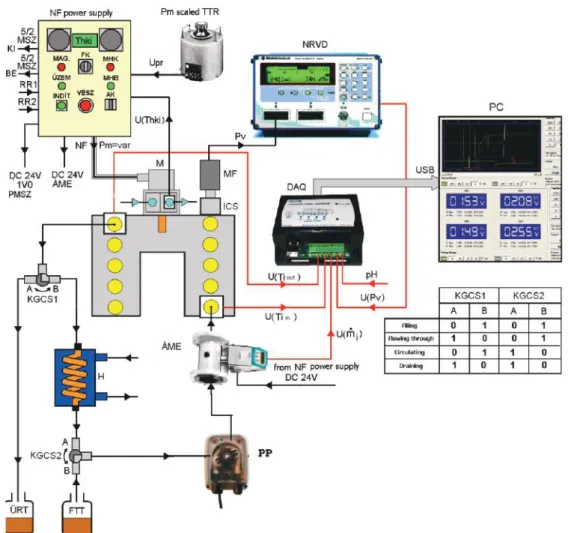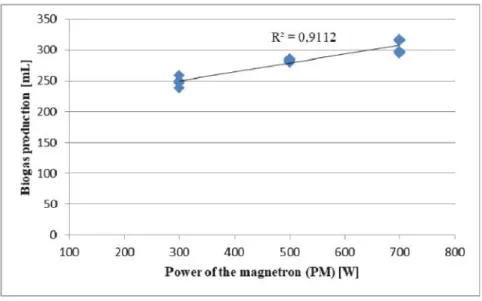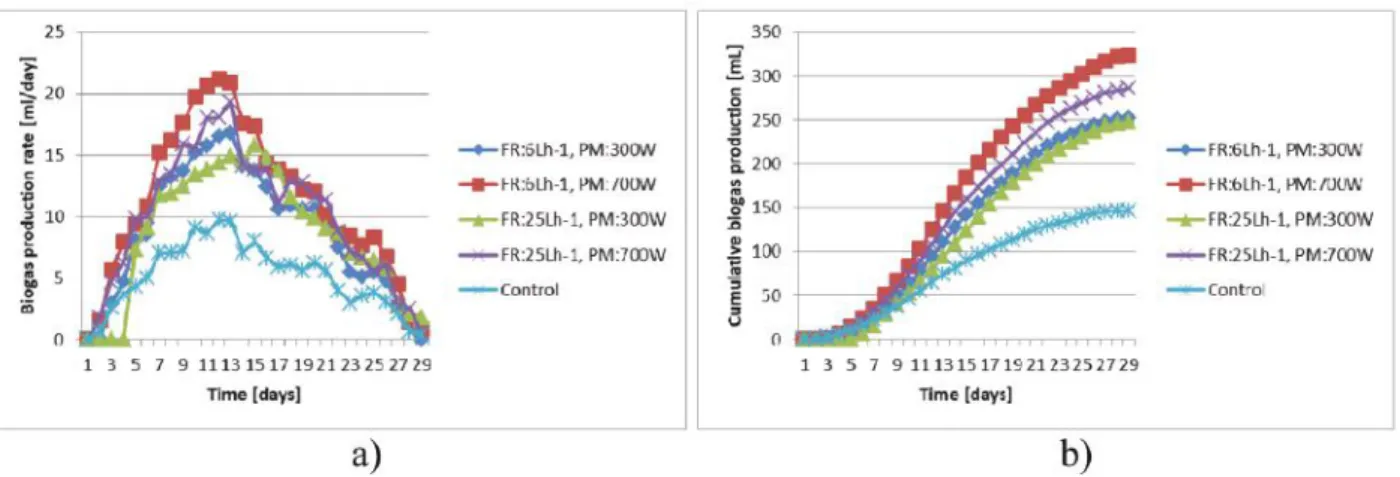Abstract
This study investigated the effects of microwave pre-treatment of meat industrial wastewater in order to enhance its anaerobic digestibility. Wastewater was treated in a continuous flow microwave system at different magnetron power (300W, 500W, 700W), volumetric flow levels (6 Lh-1, 15,5 Lh-1, 25 Lh-1) and number of treating (1, 3, 5). After treating these samples anaerobic biodegradation was carried out and correlation was investigated between power of the magnetron, volumetric flow, number of treating and biodegradability. Experiments indicated that pre-treated samples gave higher yield of biogas compared to untreated one. The maximum yield of biogas production was obtained at 700W irradiation power, 6 Lh-1volumetric flow and 5 times treating.
Keywords
pretreatment, biogas, microwave, anaerobic digestion 1. Introduction
Most of the activities using water produce sewage. As the general demand for water is growing, the amount of waste water produced and the pollution load are continually increasing worldwide. Vast majority of waste water is dispensed directly into the environment without proper treatment, to the detriment of human health, economic productivity, quality of freshwater resources and ecosystems. All of these have an impact on community well-being and the livelihood of the population.
Despite its growing volume, sewage is also a reliable source of alternative water source if the paradigm of sewage treatment is shifted from "treatment and disposal" to "recycling and resource recovery" practices. In this sense sewage is no longer a problem that requires a solution but rather a solution to the challenges that society faces today. Waste water can be a cost- effective and sustainable energy source, and it may also contain nutrients, organic substances and other useful by-products. In the context of a circular economy in which economic development is in balance with the protection of natural resources and
environmental sustainability, sewage is a widely available and valuable resource [1].
As the wastewater generated by the food industry contains very high levels of organic matter, it seems to be an obvious solution the anaerobic degradation of it and further use of the generated biogas. In addition, anaerobic fermentation reduces the amount of pathogens, stabilizes sewage without adding further additives.
In several parallel and sequential processes, organic materials mainly produce methane, carbon dioxide, other gases and residual biomass.
Sewage is mostly composed of microorganisms and extracellular polymer materials produced by the cells as part of their metabolic activity. Most of the organic matter is located within the microbial cell membranes. The cell surface of microorganisms is a semi-rigid structure that is capable of protecting the cell from osmotic lyses. This cell wall contains glycan fibers crosslinked with peptide chains that are resistant to biodegradation. For this reason, in order to achieve acceptable biodegradability, traditional digestion techniques require long hydraulic retention times. The efficiency of digestion can be increased by breaking the microbial cell walls and releasing the organic materials inside the cells [2].
The anaerobic degradation of organic matter takes place in four steps: hydrolysis, acidification phase, acetogenic phase and methanogenic phase [3]. Hydrolizing bacteria transform complex high molecular organic matter, polymers (proteins, fats, carbohydrates) into simpler compounds (amino acids, glucose, fatty acids, glycerin). These monomer hydrolysis products are further broken down by other bacterial groups. In some cases, hydrolysis phase is slow, so it can be a decisive step in the process of anaerobic digestion. In order to increase the efficiency of the hydrolysis it is necessary to apply various pre-treatment methods which for making the material available. Numerous methods can be used physical (mechanical, thermal etc.), chemical (ozonolysis, acid hydrolysis, alkaline hydrolysis, etc.), biological (fungi, enzymatic hydrolysis, etc.) pre-treatment or combination of them [4, 5 (Mosier et al, 2005; Sun and Cheng, 2002)
This study deals with the optimization of thermal pretreatment based on microwave heating, which provides rapid warming in the total volume of the material.
HUNGARIAN AGRICULTURAL ENGINEERING N° 34/2018 44-48
Published online: http://hae-journals.org/
HU ISSN 0864-7410 (Print) / HU ISSN 2415-9751(Online) DOI: 10.17676/HAE.2018.34.44
Research Letter
ENHANCING BIOGAS PRODUCTION KINETIC OF MEAT INDUSTRIAL WASTEWATER BY MICROWAVE PRETREATMENT
Author(s):
P. Kovács Veszelovszki1– G. Keszthelyi-Szabó2– P. Szendrő3 Affiliation:
1Technical Department, Faculty of Engineering, University of Szeged, 6725, Moszkvai krt. 9. , Szeged, Hungary
2Department of Process Engineering, Faculty of Engineering, University of Szeged, 6725, Moszkvai krt. 9., Szeged, Hungary
3Institute of Mechanics and Machinery, Faculty of Mechanical Engineering, Szent István University, 2100, Páter K. u. 1., Gödöllő, Hungary
Email address:
veszelov@mk.u-szeged.hu, szabog@mk.u-szeged.hu, szendro.peter@gek.szie.hu
PERIODICAL OF THE COMITTEE OF AGRICULTURAL AND BIOSYSTEM ENGINEERING OF
THE HUNGARIAN ACADEMY OF SCIENCES and
SZENT ISTVÁN UNIVERSITY Faculty of Mechanical Engineering Received: 2017.10.17.; Accepted: 2018.10.29.
2. Material and Method
Treated meat waste water comes from a medium-sized meat processing plant, primarily from the process of equipment rinsing and cleaning (slicing and packaging machines, smoking chambers). A tissue filter was used to remove larger floating solids (Table 1).
Table 1. Characteristics of wastewater
Microwave pre-treating system
Microwave pre-treating system (Fig. 1) contains a water-cooled, variable-power magnetron (M) operating at 2450 MHz. High-
voltage power supply (NF power supply) feeding the magnetron consists of two transformers, one of them produces cathode heating voltage and heating current, the other produces the anode voltage which can be controlled by the primary circuit of an external auto-transformer. With this device (PM scaled TTR) the power of the magnetron can be set as well. Electromagnetic energy of the magnetron spread over a resonant slot. Getting through this slot the energy gets in the toroidal resonator. (Kovács et al, 2012). During the operation of toroid resonator energy is given to the treated material. As a result of energy transmission the temperature of the material rises and the dielectric properties change continuously. The effect of the microwave energy intake, variable power, impedance and dielectric relationships are formed in the microwave resonator. Some of these can be measured (eg.
power dissipation, reflected power), some of them can only be determined by calculation, knowledge of the other parameters (J.
Zhu et al, 2007). Material is transferred in the continues-flow microwave treating system by a peristaltic pump (PP) with variable flow (Figure 1).
Figure 1. Microwave pre-treating system
Fermentation process, biogas measurement
Anaerobic digestion (AD) tests were carried out under controlled mesophilic temperature range (35±0,2 °C). in 12 mini continuously stirred laboratory scale reactors with 250 mL total volume, equipped with Oxitop C.
3. Results and Discussion
Effects of magnetron power on biogas production
Power of the magnetron (PM), flow rate (FR) and number of treatings (NT) profiles are shown in Table 2 with the associated responses which is biogas production.
Kinetic study of biogas production
Kinetic study of biogas production has been conducted for description and evaluation of methanogenesis by fitting the experimental data of biogas production to various kinetic equations. Biogas production rates have been simulated using linear, exponential plots. It has been assumed that biogas production rate increases linearly with increase in time and after reaching a peak value it decreases linearly to a low significant value. The linear equation for biogas production rate can be expressed by the equation below (M. D. Ghatak and P. Mahanta, 2014; S. Kumar et al, 2004)
y=a+bT (1)
where 𝑦is biogas production rate (mL), 𝑇is retention time in days, and 𝑎and 𝑏are constants obtained from the intercept and slope of the graph plotted 𝑦versus 𝑇. Slope 𝑏is positive for the ascending limb and negative for the descending limb.
The exponential plot can be represented by the equation below
y=a+bcT (2)
where 𝑦is biogas production rate (mL), 𝑇is retention time in days, 𝑎, 𝑏and 𝑐(day−1) are constants, and 𝑐is positive for the ascending limb and negative for descending limb. In this case it has been assumed that the biogas production rate increases exponentially with increase in time and reaches a peak value and thereafter decreases to a low significant value exponentially with increase in time.
The research work has been carried out in order to study the influence of microwave pretreatment on the kinetics of biogas synthesis. Microwave pretreatment could enhance the biogas production potential resulting in enhanced ultimate biogas yield as shown in Figure 3 a) and b).
Figures 4 a) and b) represent linear model fitting of biogas production rates for samples treated at different settings. The coefficient (R2) including both the ascending and descending limbs for all the groups ranged from 0.87 to 0.96.
Table 2. PM, FR, NT settings and responses associated.
Figure 2. Biogas production as function of PM
Results could be represented as function of PM, the correlation coefficient (R2) is 0,91 (Figure 2).
Similarly, Figures 5a) and b) show the exponential plot of biogas production rates including the ascending and descending limbs for each case. The coefficient of determination 𝑅2 for the
ascending and descending limb has been observed to be in the range of 0.7–0.87, which signifies that linear regression was better than that of exponential plot.
Figure 3. (a) Biogas production rate of samples treated at different settings for a retention time of 29 days. (b) Cumulative biogas production of samples treated at different settings for a retention time of 29 days.
Figure 4. a) Linear plot of the ascending limb of biogas production rate of samples treated at different settings, b) Linear plot of the descending limb of biogas production rate of samples treated at different settings
Figure 5. a) Exponential plot of the ascending limb of biogas production rate of samples treated at different settings, b) Exponential plot of the descending limb of biogas production rate of samples treated at different settings
4. Conclusions
Microwave pretreatment improved the kinetics of biogas production; high PM treatment was more effective in preconditioning of the biomass prior to anaerobic digestion and
henceforth resulted in higher yield of biogas. Biogas production potential was enhanced by thermal pretreatment which was revealed by the kinetic modeling of biogas production rates and cumulative biogas production. Biogas production rate simulated by linear model showed better correlation than exponential plot.
References
[1] WWAP (United Nations World Water Assessment Programme).: 2017. The United Nations World Water Development Report 2017. Wastewater: The Untapped Resource.
Paris, UNESCO
[2] Pavlostathis, S., Giraldo-Gomez, E.: 1991. Kinetics of anaerobic treatment. Water Science and Technology, Vol. 24 No.
8. pp. 35-59. http://dx.doi.org/10.2166/wst.1991.0217
[3] Bitton, G.: 1994. Anaerobic digestion of wastewater and sludge. Wastewater Microbiology. Wiley-liss. New York. pp. 229- 245.
[4] Adel, A. M., Abd El-Wahab, Z. H., Ibrahim, A. A., Al- Shemy, M. T.: 2010. Characterization of microcrystalline cellulose prepared from lignocellulosic materials: Part I. Acid catalyzed hydrolysis. Bioresour. Technol. Vol. 101. pp. 4446–
4455. http://dx.doi.org/10.1016/j.biortech.2010.01.047.
[5] Fernandes, T. V., Klaasse Bos, G. J., Zeeman, G., Sanders, J. P. M., Van Lier, J. B.: 2009. Effects of thermo-chemical pre- treatment on anaerobic biodegradability and hydrolysis of
lignocellulosic biomass. Bioresour. Technol. Vol. 100. pp. 2575–
2579. http://dx.doi.org/10.1016/j.biortech.2008.12.012.
[6] Mosier, N., Wyman, C., Dale, B., Elander, R., Lee, Y.Y., Holtzapple, M., Ladisch, M.: 2005. Features of promising technologies for pretreatment of lignocellulosic biomass.
Bioresour. Technol. Vol. 96. pp. 673–686.
http://dx.doi.org/10.1016/j.biortech.2004.06.025
[7] Sun, Y., Cheng, J.: 2002. Hydrolysis of lignocellulosic materials for ethanol production: a review. Bioresour. Technol.
Vol. 83. pp. 1–11.
http://dx.doi.org/10.1016/S0960-8524(01)00212-7
[8] Ghatak, M. D., Mahanta, P.:2014. Comparison of kinetic models for biogas production rate fromsawdust. International Journal of Research in Engineering and Technology, Vol. 3. No.
7. pp. 248–254.
[9] Kumar, S., Mondal, A. N., Gaikwad, S. A., Devotta, S., Singh, R. N.: 2004. Qualitative assessment of methane emission inventory from municipal solid waste disposal sites: a case study.
Atmospheric Environment, Vol. 38. No. 29. pp. 4921–4929.
http://dx.doi.org/10.1016/j.atmosenv.2004.05.052


